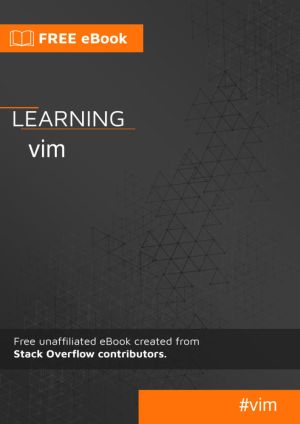Learning Vim
by Stack Overflow Community
DescriptionTable of ContentsDetailsHashtagsReport an issue
It is an unofficial and free Vim book created for educational purposes. All the content is extracted from Stack Overflow Documentation, which is written by many hardworking individuals at Stack Overflow. 






Book Description
Vim is a console-based multi-mode (modal) text editor. It is widely used and available by default on all Unix, Linux, and Apple OS X systems. Vim has a large active community and a wide user base. The editor supports all popular programming languages, and many plugins are available to extend its features.It is an unofficial and free Vim book created for educational purposes. All the content is extracted from Stack Overflow Documentation, which is written by many hardworking individuals at Stack Overflow.
This open book is licensed under a Creative Commons License (CC BY-SA). You can download Learning Vim ebook for free in PDF format (2.2 MB).
Table of Contents
Chapter 1
Getting started with vim
Chapter 2
:global
Chapter 3
Advantages of vim
Chapter 4
Ask to create non-existant directories upon saving a new file
Chapter 5
Autocommands
Chapter 6
Auto-Format Code
Chapter 7
Buffers
Chapter 8
Building from vim
Chapter 9
Command-line ranges
Chapter 10
Configuring Vim
Chapter 11
Converting text files from DOS to UNIX with vi
Chapter 12
Differences between Neovim and Vim
Chapter 13
Easter Eggs
Chapter 14
Enhanced undo and redo with a undodir
Chapter 15
Exiting Vim
Chapter 16
Extending Vim
Chapter 17
Filetype plugins
Chapter 18
Find and Replace
Chapter 19
Folding
Chapter 20
Get :help (using Vim's built-in manual)
Chapter 21
How to Compile Vim
Chapter 22
Indentation
Chapter 23
Inserting text
Chapter 24
Key Mappings in Vim
Chapter 25
Macros
Chapter 26
Manipulating text
Chapter 27
Modes - insert, normal, visual, ex
Chapter 28
Motions and Text Objects
Chapter 29
Movement
Chapter 30
Normal mode commands
Chapter 31
Normal mode commands (Editing)
Chapter 32
Plugins
Chapter 33
Regular expressions
Chapter 34
Regular expressions in Ex Mode
Chapter 35
Saving
Chapter 36
Scrolling
Chapter 37
Searching in the current buffer
Chapter 38
Solarized Vim
Chapter 39
Spell checker
Chapter 40
Split windows
Chapter 41
Substitution
Chapter 42
The dot operator
Chapter 43
Tips and tricks to boost productivity
Chapter 44
Useful configurations that can be put in .vimrc
Chapter 45
Using ex from the command line
Chapter 46
Using Python for Vim scripting
Chapter 47
vglobal: Execute commands on lines that do not match globally
Chapter 48
Vim Options
Chapter 49
Vim Registers
Chapter 50
Vim Resources
Chapter 51
Vim Text Objects
Chapter 52
Vimscript
Chapter 53
Whitespace
Book Details
Title
Learning Vim
Subject
Computer Science
Publisher
RIP Tutorial
Published
2019
Pages
157
Edition
1
Language
English
PDF Size
2.2 MB
License

Related Books

This book presents a synopsis of six emerging themes in adult mathematics/numeracy and a critical discussion of recent developments in terms of policies, provisions, and the emerging challenges, paradoxes and tensions. It also offers an extensive review of the literature adult mathematics education. Why do adults want to learn mathematics? Did they...

This book summarizes the vast amount of research related to teaching and learning probability that has been conducted for more than 50 years in a variety of disciplines. It begins with a synthesis of the most important probability interpretations throughout history: intuitive, classical, frequentist, subjective, logical propensity and axiomatic vie...

It argues that the main purpose of educational research is to improve student learning, and that international comparative studies are no exception....

This book provides a systematic overview of experiences with Inquiry-Based Learning (IBL) and undergraduate research (UR) in German universities, covering both research universities (Universitäten) and universities of applied sciences (Fachhochschulen). Divided into three parts, the book starts with the principles and common practices of IBL/UR at...

This book deals with the relevance of recognition and validation of non-formal and informal learning in education and training, the workplace and society. In an increasing number of countries, it is at the top of the policy and research agenda ranking among the possible ways to redress the glaring lack of relevant academic and vocational qualificat...

This book provides a practical philosophy for promoting students' sophisticated thinking from Early Childhood to PhD in ways that explicitly interconnect across the years of education. It will help teachers, academics and the broader learning and teaching community to understand and implement these connections by introducing a conceptual frame...

